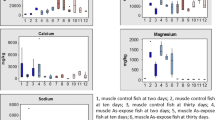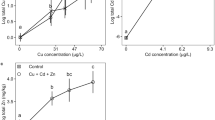Abstract
Juvenile rainbow trout were fed semi-purified diets containing graded levels of disodium arsenate heptahydrate (DSA) for 12–24 weeks under standard laboratory conditions to define the maximum acceptable toxicant concentration (MATC) and to correlate signs of toxicity with diet and tissue arsenic concentrations. The MATC for DSA was between 13 and 33 μg As/g diet or 0.281–0.525 mg As/kg body weight/day. The most sensitive and reliable indicator of chronic dietary DSA toxicity in rainbow trout was chronic inflammation of the gallbladder wall. Chronic inflammatory changes in the sub-epithelial tissues of the gallbladder wall were evident in 71% of rainbow trout exposed to 33 μg As/g diet for 24 weeks, and 100% of rainbow trout exposed to 65 μg As/g diet for 24 weeks or 49 μg As/g diet for 12 weeks. No fish exposed to 13 μg As/g diet or less for up to 24 weeks showed any demonstrable gallbladder lesions or any other ill effect of arsenic exposure. Other signs of chronic dietary DSA toxicity to rainbow trout included decreased growth rate, mild to moderate anemia, and, at higher levels of exposure, active feed refusal leading to decreased feed consumption. Mild nephrocalcinosis was noted in one experiment where kidney arsenic residues exceeded 14 μg As/g tissue dry weight.
Similar content being viewed by others
References
AOAC (1980) Official methods of analysis of the Association of Official Analytical Chemists, 13th ed. Horwitz W (ed) Association of Official Analytical Chemists, Washington, DC, p 695
Atchison GJ, Henry MG, Sandheinrich MB (1987) Effects of metals on fish behaviour: A review. Environ Biol Fish 18(1): 11–25
Brown MM, Rhyne BC, Goyer RA, Fowler BA (1976) Intracellular effects of chronic arsenic administration on renal proximal tubule cells. J Toxicol Environ Health 1:505–514
Buck WB, Osweiler GD, van Gelder GA (1976) Clinical and diagnostic veterinary toxicology, 2nd ed. Kendall/Hunt Publishing Co, Dubuque, IA
Bunce GE, Saacke RG, Mullins J (1980) The morphology and pathogenesis of magnesium deficiency-induced nephrocalcinosis. Exp Mol Pathol 33:203–210
Byron WR, Bierbower GW, Brouwer JB, Hansen WH (1967) Pathologic changes in rats and dogs from two-year feeding of sodium arsenite or sodium arsenate. Toxicol Appl Pharmacol 10:132–147
Cockell KA (1990) Chronic toxicity of dietary arsenic to rainbow troutOncorhynchus mykiss. PhD thesis, University of Guelph, Guelph, Ontario, Canada
Cockell KA, Hilton JW (1988) Preliminary investigations on the comparative chronic toxicity of four dietary arsenicals to juvenile rainbow trout (Salmo gairdneri R.). Aquat Toxicol 12:73–82
Cooper BL, Calhoun MC, Engdahl GR, Kuhlmann SR, Baldwin BC Jr, Jones LP (1988) Toxicity of ortho-arsenic acid fed to sheep. J Anim Sci 66(S1):371
Cowey CB, Knox D, Adron JW, George S, Pirie B (1977) The production of renal calcinosis by magnesium deficiency in rainbow trout (Salmo gairdneri). Br J Nutr 38:127–135
Ferguson HW, Moccia RD, Sippel AJ, Geraci JR (1984) Disease in Ontario hatcheries. Section 6 In: Castledine AJ, Cho CY, Ferguson HW, Hynes JD, Slinger SJ (eds) Handbook of fish culture. Ontario Ministry of Natural Resources. 48 pp
Feussner JR, Shelburne JD, Bredehoeft S, Cohen HJ (1979) Arsenic-induced bone marrow toxicity: Ultrastructural and electronprobe analysis. Blood 53(5):820–827
Gingerich WH (1982) Hepatic toxicology of fishes. In: Weber LJ (ed) Aquatic toxicology. Raven Press, NY, pp 55–105
Ginsburg JM (1965) Renal mechanism for excretion and transformation of arsenic in the dog. Am J Physiol 208(5):832–840
Ginsburg JM, Lotspeich WD (1963) Interrelations of arsenate and phosphate transport in the dog kidney. Am J Physiol 205(4):707–714
Harris IM, McAlister JM, Prankerd TAJ (1957) The relationship of abnormal red cells to the normal spleen. Clin Sci (London) 16:223–230
Harrison JG, Richards RH (1979) The pathology and histopathology of nephrocalcinosis in rainbow troutSalmo gairdneri in fresh water. J Fish Dis 2:1–12
Hicks BD, Hilton JW, Ferguson HW (1984) Influence of dietary selenium on the occurrence of nephrocalcinosis in the rainbow trout,Salmo gairdneri Richardson. J Fish Dis 7:379–389
Hilton JW, Slinger SJ (1981) Nutrition and feeding of rainbow trout. Can Spec Publ Fish Aquat Sci 55, 15 pp
Humphreys DJ (1988) Veterinary toxicology, 3rd ed. Bailliere Tindall, London
Isaacs R (1928) The effect of arsenic on the maturation of red blood cells. Folia Haematol 37:389–404
Ishinishi N, Tsuchiya K, Vahter M, Fowler BA (1986) Arsenic. In: Friberg L, Nordberg GF, Vouk V (eds) Handbook on the toxicology of metals, 2nd ed. Elsevier Science Publishers B.V., NY, Chap 3, pp 43–83
Iwama GK, Greer GL, Randall DJ (1986) Changes in selected haematological parameters in juvenile Chinook salmon subjected to a bacterial challenge and a toxicant. J Fish Biol 28:563–572
Jones TC, Hunt RD (1983) Veterinary pathology. Lea and Febiger, Philadelphia, PA
Kinne R (1984) Role of sodium cotransport systems in epithelial transport. Ann NY Acad Sci 435:39–46
Kyle RA (1970) Inorganic arsenic intoxication. Chapter 34A In: Sunderman FW, Sunderman FW, Jr. (eds) Laboratory diagnosis of diseases caused by toxic agents. Warren H Green, Inc, St Louis, MO, pp 367–375
Kyle RA, Pease GL (1965) Hematologic aspects of arsenic intoxication. New Engl J Med 273(1): 18–23
Laudanna AA, Ferreyra NP, Cerri GG, Bettarello A (1987) Thickening of the gallbladder wall in alcoholic hepatitis verified by ultrasonographic examination: Its clinical implications. Scand J Gastroenterol 22:521–524
Leevy CM, Popper H, Sherlock S (1976) Diseases of the liver and biliary tract: Standardization of nomenclature, diagnostic criteria, and diagnostic methodology. Yearbook Medical Publishers, Inc, Chicago, IL
Luna LG (1968) Manual of histologic staining of the Armed Forces Institute of Pathology. McGraw-Hill, London
Mackie AM (1982) Identification of the gustatory feeding stimulants. Chapter 15 In: Hara TJ (ed) Chemoreception in fishes: Developments in aquaculture and fisheries science, volume 8. Elsevier Scientific Publishing Co, NY, pp 275–291
Mahaffey KR, Fowler BA (1977) Effects of concurrent administration of lead, cadmium and arsenic in the rat. Environ Health Perspect 19:165–171
Martinez G, Cebrian M, Chamorro G, Jauge P (1983) Urinary uroporphyrin as an indicator of arsenic exposure in rats. Proc West Pharmacol Soc 26:171–174
Moxham JW, Coup MR (1968) Arsenic poisoning of cattle and other domestic animals. NZ Vet J 16:161–165
Mulcahy MF, Collins N, McAuliffe T (1983) Nephrocalcinosis in freshwater and saltwater-farmed rainbow trout in Ireland. Irish Fish Invest Ser A 23:77–80
NAS (1977) Arsenic. National Academy of Sciences, Washington, DC
Neiger RD, Osweiler GD (1989) Effects of subacute low level dietary sodium arsenite on dogs. Fund Appl Toxicol 13:439–451
Newberne PM, Russo R, Wogan GN (1966) Acute toxicity of aflatoxin B1 in the dog. Path Vet 3:331–340
NRCC (1978) Effects of arsenic in the Canadian environment. NRCC No. 15391, National Research Council of Canada, Associate Committee on Scientific Criteria for Environmental Quality, Ottawa, Canada
Oladimeji AA, Qadri SU, de Freitas ASW (1984a) Measuring the elimination of arsenic by the gills of rainbow trout (Salmo gairdneri) by using a two compartment respirometer. Bull Environ Contam Toxicol 32:661–668
—,—,— (1984b) Long-term effects of arsenic accumulation in rainbow trout,Salmo gairdneri. Bull Environ Contam Toxicol 32:732–741
Peters G, Schwarzer R (1985) Changes in hemopoietic tissue of rainbow trout under influence of stress. Dis Aquat Org 1:1–10
SAS (1982) SAS user's guide: Statistics. SAS Institute Inc, Gary, NC
Schneiderman DJ (1988) Hepatobiliary abnormalities of AIDS. Gastroenterol Clin North Am 17(3):615–630
Schoenfield LJ (1977) Diseases of the gallbladder and biliary system. John Wiley & Sons, NY
Shirachi DY, Johansen MG, McGowan JP, Tu S-H (1983) Tumorigenic effect of sodium arsenite in rat kidney. Proc West Pharmacol Soc 26:413–415
Smart GR, Knox D, Harrison JG, Ralph JA, Richards RH, Cowey CB (1979) Nephrocalcinosis in rainbow troutSalmo gairdneri Richardson; the effect of exposure to elevated CO2 concentrations. J Fish Dis 2:279–289
Sollmann TH (1957) A manual of pharmacology and its applications to therapeutics and toxicology, 8th ed. WB Saunders Co, Philadelphia, PA
Sorensen EMB, Henry RE, Ramirez-Mitchell R (1979) Arsenic accumulation, tissue distribution and cytotoxicity in teleosts following indirect aqueous exposures. Bull Environ Contam Toxicol 21:162–169
Tacon AGJ (1985) Nutritional fish pathology: Morphological signs of nutrient deficiency and toxicity in farmed fish. ADCP/REP/ 85/22, Aquaculture Development and Coordination Programme, United Nations Development Programme, Food and Agriculture Organization of the United Nations, Rome
Tsukamoto H, Parker HR, Gribble KH, Mariassy A, Peoples SA (1983) Nephrotoxicity of sodium arsenate in dogs. Am J Vet Res 44(12):2324–2330
Voth-Beach LM, Shrader DE (1986) Reduction of interferences in the determination of arsenic and selenium by hydride generation. Spectroscopy (Springfield, OR) 10:60–65
Westhoff DD, Samaha RJ, Barnes A, Jr (1975) Arsenic intoxication as a cause of megaloblastic anemia. Blood 45(2):241–246
WHO (1981) Arsenic. Environmental Health Criteria 18, World Health Organization, Geneva
Williamson RCN (1988) Acalculous disease of the gallbladder. Gut 29:860–872
Author information
Authors and Affiliations
Additional information
Supported by the Natural Sciences and Engineering Research Council of Canada and the Ontario Ministry of Agriculture and Food
Rights and permissions
About this article
Cite this article
Cockell, K.A., Hilton, J.W. & Bettger, W.J. Chronic toxicity of dietary disodium arsenate heptahydrate to juvenile rainbow trout (Oncorhynchus mykiss). Arch. Environ. Contam. Toxicol. 21, 518–527 (1991). https://doi.org/10.1007/BF01183873
Received:
Issue Date:
DOI: https://doi.org/10.1007/BF01183873




